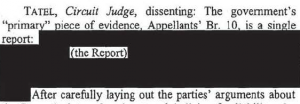No Easy Day, WikiLeaks, and Mitt’s 47%: Three Different Approaches to Illicitly-Released Information
[youtube]nYXXkOLgMqQ[/youtube]
Last week, DOD issued a guidance memo instructing DOD personnel what they are–and are not–permitted to do with the Matt Bissonnettte book, No Easy Day, that they claim has sensitive and maybe even classified information. DOD personnel,
- are free to purchase NED;
- are not required to store NED in containers or areas approved for the storage of classified information, unless classified statements in the book have been identified;
- shall not discuss potentially classified and sensitive unclassified information with persons who do not have an official need to know and an appropriate security clearance;
- who possess either firsthand knowledge of, or suspect information within NED to be classified or sensitive, shall not publically speculate or discuss potentially classified or sensitive unclassified information outside official U.S. Government channels (e.g., Chain-of-Command, Public Affairs, Security, etc.);
- are prohibited from using unclassified government computer systems to discuss potentially classified or sensitive contents ofNED, and must not engage in online discussions via social networking or media sites regarding potentially classified or sensitive unclassified information that may be contained in NED.
The memo points to George Little’s earlier flaccid claims that the book contains classified information as the basis for this policy, even though those claims fell far short of an assertion that there was actually classified information in the book.
The strategy behind this policy seems to be to accept the massive release of this information, while prohibiting people from talking about what information in the book is classified or sensitive–or even challenging Little’s half-hearted claim that it is classified. Moreover, few of the people bound by this memo know what the President insta-declassified to be able to tell his own version of the Osama bin Laden raid, so the memo also gags discussions about information that has likely been declassified, not to mention discussions about the few areas where Bissonnette’s version differs from the Administration’s official version.
Still, it does let people access the information and talk about it generally.
Compare that policy with the Administration’s three-prong approach to WikiLeaks information:
- Government employees cannot discuss–and are not supposed to consult at all–WikiLeaks cables. The treatment of Peter Van Buren for–among other things–linking to some WikiLeaks cables demonstrates the lengths to which the government is willing to go to silence all discussion of the cables. (Though I imagine the surveillance of social media will be similar to enforce the DOD guidance.)
- Gitmo lawyers not only cannot discuss material–like the dodgy intelligence cable that the government used to imprison Latif until he died of still undisclosed causes or the files that cite tortured confessions to incriminate other detainees–released by WikiLeaks unless the press speaks of them first. But unlike DOD personnel who do not necessarily have a need to know, Gitmo lawyers who do have a need to know couldn’t consult WikiLeaks except in closely controlled secure conditions.
- The Government will refuse to release cables already released under FOIA. While to some degree, this strategy parallels the DOD approach–whereas the NED policy avoids identifying which is and is not classified information, the WikiLeaks policy avoids admitting that cables everyone knows are authentic are authentic, the policy also serves to improperly hide evidence of illegal activity through improper classification.
Now, one part of the Administration’s logic behind this approach to purportedly classified information (thus far without the legal proof in either case, or even a legal effort to prove in the case of Bissonnette) is to limit discussion of information that was allegedly released via illegal means. Read more →



